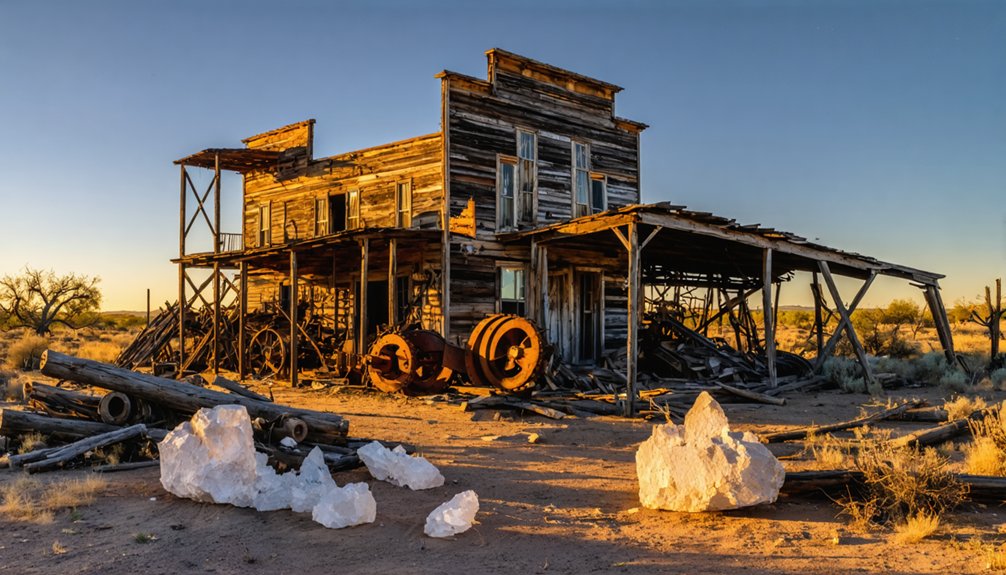You’ll find Grit nestled in Mason County’s rugged Hill Country along Highway 29, where limestone hills cradle the remnants of a once-thriving coal mining town. During its peak in the early 1900s, nearly 10,000 residents called this community home, with daily life centered around mining operations that produced up to 2,000 tons of coal daily. Today, weathered foundations, scattered mining equipment, and a historic cemetery tell tales of Texas’s dynamic mining past.
Key Takeaways
- Grit was a coal mining community in northern Texas that thrived in the early 1900s before declining during the Great Depression.
- The town’s economy relied heavily on coal mining and cotton, making it vulnerable when both industries collapsed.
- Located in Mason County’s Hill Country, Grit sits at 1,716 feet elevation and features scattered ruins of its mining past.
- Historical remnants include building foundations, abandoned mining equipment, and a two-acre cemetery established in the early 1900s.
- The ghost town’s cemetery contains unique burial markers including rounded stone piles, iron crosses, and wooden markers reflecting its diverse community.
The Rise of a Coal Mining Powerhouse
As coal mining gained prominence in northern Erath and southern Palo Pinto counties during the late 1880s, the region surrounding Grit emerged as Texas’ largest coal producer.
You’d find the Texas & Pacific Coal Company dominating the landscape with up to fifteen mine sites around Thurber, churning out an impressive 1,500 to 2,000 tons daily at peak production.
In Strawn, near Grit, you could witness the entrepreneurial spirit of William and Harvey Johnson, who’d shifted from feed and lumber to coal mining around 1900.
The area’s rich bituminous coal deposits proved essential for industrial development, and by 1913, Texas’ commercial coal production reached 2.4 million tons.
Mining operations employed hundreds to over a thousand men, transforming the region into a significant economic powerhouse that fueled everything from locomotives to sugar refineries. Similar to other mining towns, a thriving community developed with two schools and churches. This mining tradition continued well into the modern era, with companies like NRG required to post bonds for reclamation to ensure proper land restoration after mining ceased.
Daily Life in Grit’s Golden Years
Life in Grit during its golden years revolved around the demanding rhythms of coal mining, with a tight-knit community of nearly 10,000 residents sharing modest company homes and basic amenities.
You’d wake early for mining shifts, heading to work in closely packed neighborhoods where everyone knew their neighbors. Your family would draw water from communal wells and share daily chores with others on your street. Workers had to use company scrip instead of regular currency at the town store.
Despite harsh housing conditions, you’d find comfort in community events – dances, social gatherings, and shared meals brought everyone together. If you weren’t working the mines, you might run a local shop or teach at the small schoolhouse, which doubled as a meeting place.
In this hardscrabble town, community spirit thrived through shared gatherings, while shopkeepers and teachers formed the backbone of daily life.
Your children would help contribute to the family’s income, while rivalries with nearby towns like Stinnett and Plemons added spice to your social life. Just like in Plemons, having a reliable way to navigate natural hazards was crucial, as many relied on horses to detect quicksand when crossing treacherous areas.
Economic Forces Behind the Decline
When cotton prices plummeted in the early 20th century, Grit’s economic foundation began to crumble. The town’s cotton gins, once bustling centers of local commerce, became unprofitable and obsolete.
You’d have seen the cascading effects as declining farm incomes led to reduced tax revenues, crippling the town’s ability to maintain essential services. With limited infrastructure in small towns like Grit, attracting replacement businesses or industries proved nearly impossible.
The Great Depression of the 1930s dealt another devastating blow, accelerating Grit’s economic decline. Without a railroad connection to sustain trade, the town couldn’t adapt to changing transportation patterns that favored rail-connected communities.
Like Medicine Mound in Texas, Grit struggled against the combined pressures of agricultural decline and changing transportation networks.
As businesses shuttered and jobs disappeared, you’d have witnessed a steady population migration as families sought opportunities elsewhere. The lack of economic diversification left Grit vulnerable, and like many single-industry towns of that era, it couldn’t survive the perfect storm of agricultural collapse and infrastructural isolation.
Natural Landscape and Geographic Features
The natural setting of Grit tells its own story, distinct from the economic hardships that sealed its fate.
You’ll find this ghost town nestled in Mason County‘s rugged Hill Country, where Highway 29 cuts through limestone hills about 6 miles northwest of Mason. The landscape diversity surrounding Grit showcases the ecological significance of central Texas, with its rolling terrain dotted by live oaks, Ashe juniper, and native grasses. Standing at 1,716 feet elevation, the town offers expansive views of the surrounding countryside.
Tucked between limestone hills and native oaks, Grit’s ghostly remains tell stories through the rugged beauty of Mason County.
The area’s tough, gritty soil once supported modest cotton cultivation despite challenging growing conditions. You’re in an area where Honey Creek’s waters intermittently flow, fed by seasonal rains that charge the Edwards and Trinity aquifers below.
The semi-arid climate shapes a terrain that’s supported ranching more than farming, while white-tailed deer and wild turkeys roam freely through a mosaic of brush and woodland characteristic of this distinctive Hill Country environment.
Abandoned Structures and Historical Remnants
You’ll find scattered building foundations marking where Grit’s original structures once stood, providing a ghostly footprint of the former settlement.
Like the ruins of quicksilver mines in Terlingua, these abandoned structures tell the story of a once-bustling Texas community.
The town’s cemetery contains weathered grave markers that chronicle the lives of early residents and serve as one of the few remaining tangible links to Grit’s past. Like many communities across Texas including Old Alton Bridge, only the cemetery remains as evidence of the once-thriving town.
Mining equipment remnants, though sparse, can still be spotted among the ruins, hinting at the resource extraction activities that once sustained this Mason County community.
Mining Equipment Remains
Scattered across Grit’s abandoned mining site, rusted machinery parts and deteriorating equipment tell the story of its silver mining heyday.
You’ll find remnants of the Presidio Mining Company’s operations, including mule-drawn ore wagons and cart frames, either visible or partially buried in the desert sand.
The mining machinery decay is evident in the ore processing remnants – abandoned stamps, grinding mills, and conveyor systems that once processed precious silver ore.
The dry Texas climate has preserved some metal components, but decades of exposure have taken their toll.
You’ll need to watch your step, as unmarked mine shafts and unstable equipment pose safety risks.
Warning signs mark areas of structural instability, while mercury vapor contamination persists near processing sites.
Building Foundations Today
Weathered foundations scattered throughout Grit’s landscape reveal the town’s architectural heritage through distinct building footprints.
You’ll find residential foundations resting on simple stone or brick piers that once elevated wooden floors, while more substantial commercial footings showcase the town’s economic core through wider brick and mortar construction.
Along the former main street, you can trace the robust foundation types of general stores and possibly a bank, with adjacent outbuilding remains nearby.
The town’s institutional buildings left behind complex stone foundations, including the school’s multi-room layout and Protestant church’s rectangular design with entry vestibules.
On Grit’s outskirts, you’ll discover agricultural foundations featuring circular layouts for corrals and windmills, along with scattered barn and shed footprints marked by basic stone piers.
Cemetery and Grave Markers
Beyond the architectural remnants stands Grit’s historical cemetery, established in the early 1900s and spanning roughly two acres of rugged terrain.
You’ll find unique burial practices shaped by the rocky soil, where graves feature rounded stone piles instead of traditional in-ground plots. The grave marker artistry reflects the diverse community, with handcrafted iron crosses, wooden markers, and personalized folk art memorials dotting the landscape.
Many markers tell stories of miners who succumbed to accidents and mercury poisoning, while others commemorate victims of the 1918 influenza epidemic.
Though time and weather have worn away some headstones, the cemetery remains culturally significant. During Dia de los Muertos, you’ll see the grounds transformed with colorful flowers, candles, and paper streamers, keeping the connection to past generations alive.
Legacy in Texas Mining History

While many Texas ghost towns faded into obscurity, Grit’s mining legacy played a significant role in the state’s broader mineral extraction history.
You’ll find its story intertwined with prominent mining centers like Shafter, known for the “richest acre in Texas,” and Terlingua’s mercury operations. The town’s mining heritage reflects the boom-and-bust pattern that defined West Texas’ resource-dependent communities, where populations swelled to thousands during peak production years.
As part of the region’s extensive mining network, Grit contributed to an era that transformed Texas’s economic landscape.
Though the town couldn’t survive the eventual decline in mineral demand, its cultural significance lives on through preserved structures and historical records, joining other ghost towns that now serve as powerful reminders of Texas’s dynamic mining past.
Frequently Asked Questions
Are There Any Paranormal Activities Reported in Grit’s Abandoned Buildings?
Like footprints in shifting desert sand, you won’t find documented ghost sightings in Grit’s buildings. While Texas ghost towns often spawn haunted legends, no specific paranormal activities are officially reported here.
What Happened to the Mining Equipment After the Town Was Abandoned?
You won’t find mining equipment in Grit since it wasn’t a mining town. When people left, they took their farming tools and personal belongings, unlike mining ghost towns that left machinery behind.
Did Any Famous Outlaws or Historical Figures Visit Grit?
You won’t find records of famous outlaws or historical figures visiting Grit. Unlike other Texas ghost towns known for legendary visitors, this small farming settlement didn’t attract documented high-profile characters.
Can Visitors Legally Explore Grit’s Remaining Structures Today?
You’ll need explicit permission since most structures are on private property. Check local regulations and visitor guidelines before exploring – unauthorized access could result in trespassing charges.
Were There Any Major Accidents or Disasters in Grit’s Coal Mines?
Time has swallowed the secrets, but you won’t find any documented coal mine accidents or disaster reports specific to Grit’s mines in historical records. Safety evolution likely protected its workers.
References
- https://www.youtube.com/watch?v=phjUE19A8HM
- https://www.hipcamp.com/journal/camping/texas-ghost-towns/
- https://mix941kmxj.com/texas-ghost-town-visit/
- https://www.southernthing.com/ruins-in-texas-2640914879.html
- https://en.wikipedia.org/wiki/List_of_ghost_towns_in_Texas
- https://www.texasescapes.com/TexasHillCountryTowns/Grit-Texas.htm
- https://www.tshaonline.org/handbook/entries/grit-tx
- https://www.texasescapes.com/TOWNS/Texas_ghost_towns.htm
- https://www.tarleton.edu/the-industrious-historian/2011/05/26/coal-mines-in-palo-pinto-county-tp-wasnt-the-only-game-in-town/
- https://www.rrc.texas.gov/surface-mining/historical-coal-mining/



